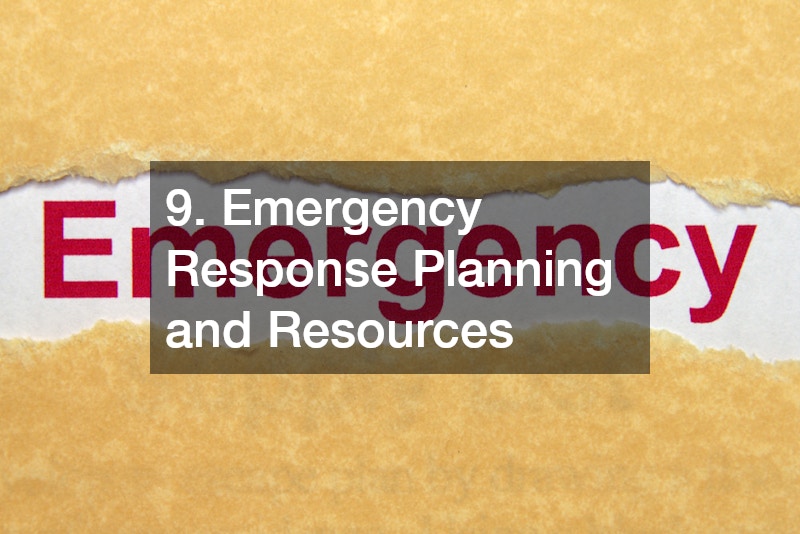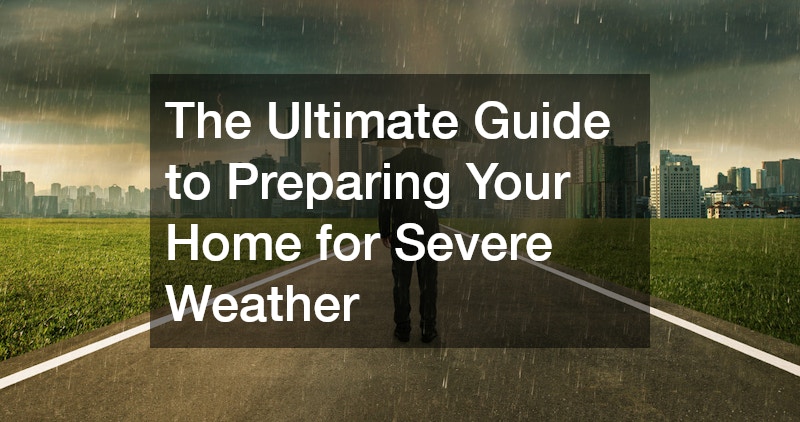
Severe weather can strike without warning, bringing hurricanes, tornadoes, floods, and winter storms that pose significant risks to both life and property. Homes are more than just shelters—they represent safety, investment, and comfort. When these natural events occur, an unprepared home can suffer catastrophic damage, from structural failure to flooding, leaving homeowners facing expensive repairs and safety hazards. Even minor oversights, like a leaky pipe or a weakened roof shingle, can escalate into serious problems under extreme weather conditions.
Preparing your home for severe weather is not merely about installing a few storm shutters or buying sandbags; it is about proactive maintenance, strategic upgrades, and informed planning. By reinforcing the structural integrity of your home, safeguarding your water and electrical systems, and implementing preventive measures, you can minimize the risks of property damage and protect your family. Moreover, early preparation saves money in the long run, reducing the likelihood of emergency repairs and insurance claims.
This guide is designed to provide actionable tips for homeowners who want to strengthen their homes against the unpredictable forces of nature. From structural reinforcements and plumbing checks to storm shelters and emergency planning, each section offers step-by-step guidance to ensure your home is resilient, safe, and ready for any severe weather scenario.
1. Strengthening Your Home’s Structure Against Storm Damage

The first line of defense against severe weather is a strong and resilient structure. Storms with high winds, torrential rain, and flying debris can exploit any weak points in your home, causing significant damage. Regularly assessing your home’s structural integrity is essential. Start with a thorough inspection of your foundation, walls, and roof. Look for cracks, settling, or signs of water intrusion, which can indicate vulnerabilities. Even small cracks in concrete or masonry may expand under pressure during storms.
For homeowners who notice structural issues, hiring professionals for foundation repair is critical. Licensed contractors can address problems such as uneven settling, soil erosion, or weakened support beams. These repairs prevent long-term issues that could compromise your home during severe weather events. A structurally sound foundation acts as a bedrock of protection, reducing the risk of catastrophic damage.
Roofing is another vital component of storm preparedness. High winds can lift shingles, loosen flashing, and clog gutters, leading to water infiltration. Schedule inspections with local roofing repair services to ensure your roof is resilient. Check that shingles are intact, flashing around chimneys and vents is secure, and gutters are free of debris. Reinforcing eaves and soffits and installing storm straps can add extra protection against wind uplift.
Additionally, consider external reinforcements such as hurricane clips or braces for roof trusses. These improvements may seem minor but significantly enhance your home’s ability to withstand severe storms. By focusing on the foundation, walls, and roof, you create a strong structural framework that protects your home and family, providing peace of mind during extreme weather.
2. Safeguarding Water Systems and Preventing Flood Damage
Water systems are particularly vulnerable during severe weather, with plumbing failures and flooding posing major risks. Heavy rain or rapid snowmelt can overwhelm drains, while high winds may damage external pipes. Preventing water-related disasters requires both inspection and maintenance. Start by checking visible pipes for corrosion, leaks, or loose fittings. Repairing these issues promptly can prevent more serious flooding during storms.
Professional pipe repair services are invaluable for addressing vulnerabilities in your plumbing system. Licensed plumbers can replace worn or damaged pipes, reinforce joints, and install protective measures such as backflow preventers. Regular inspections reduce the likelihood of unexpected leaks or bursts when your home is under stress from severe weather.
Another key component of your home’s water system is the water pressure tank. These tanks ensure consistent water supply and pressure, even under high demand or when municipal systems are disrupted. Routine maintenance, such as checking pressure levels and inspecting for corrosion, helps maintain reliable performance. A malfunctioning water tank during a storm can exacerbate plumbing issues, causing leaks, pipe bursts, or even flooding in your basement or utility areas.
Flood prevention also involves external measures. Ensure proper grading around your home to direct water away from the foundation. Clean gutters and downspouts to avoid overflow, and consider installing sump pumps in flood-prone areas. These proactive steps work in tandem with pipe maintenance and water tank inspections to reduce flood risks.
By prioritizing your home’s plumbing and water systems, you protect both property and personal safety. Taking preventive action now ensures that your home can withstand heavy rain, frozen pipes, and high-pressure demands, keeping your household functional and secure when severe weather strikes.
3. Preparing Your Home’s Cooling and Electrical Systems
Extreme weather can place immense stress on a home’s cooling and electrical systems. During summer storms, heat waves, or sudden power outages, a malfunctioning HVAC system can compromise both comfort and safety. Maintaining your air conditioning, ventilation, and electrical systems is essential for storm preparedness.
Begin by scheduling regular cooling repair services. Inspect air filters, clean vents, and ensure that compressors and refrigerant lines are in optimal condition. Preventative maintenance reduces the risk of system failure during heatwaves or storm-related disruptions. For older systems, consider upgrading components or installing smart thermostats to improve efficiency and reliability.
Electrical preparedness goes hand in hand with cooling maintenance. Power outages are common during severe storms, and a reliable backup solution is crucial. Local generator services can assist with both the installation and routine maintenance of backup power systems. When selecting a generator, consider capacity, fuel type, and automatic transfer switches to ensure seamless operation during outages. Regularly test generators and maintain fuel supplies to avoid last-minute surprises.
Additional precautions include securing electrical panels and wiring against water intrusion. Ensure that outdoor outlets are protected with weatherproof covers and inspect all circuits for wear or corrosion. Surge protectors for critical appliances, such as refrigerators and medical equipment, provide an added layer of safety.
Proactive attention to cooling and electrical systems not only maintains comfort but also prevents secondary hazards. For example, a failed HVAC system combined with power loss can lead to heatstroke, frozen pipes, or electrical fires. By maintaining these systems and enlisting professional services for repair or upgrades, you ensure your home remains functional, safe, and resilient during even the most severe weather events.
4. Detecting Hidden Water Damage Risks

Hidden water damage can silently weaken a home, creating significant risks during severe weather. Leaks beneath floors, behind walls, or under slabs may go unnoticed until heavy rains exacerbate the problem. Early detection is crucial to prevent structural damage, mold growth, and costly repairs.
Homeowners should regularly inspect areas prone to hidden water damage. Look for signs such as discolored walls, musty odors, warped flooring, or bubbling paint. These indicators often precede larger problems, signaling leaks or moisture accumulation. Additionally, examine basements and crawl spaces for standing water, condensation, or damp soil.
Professional slab leak detection companies can provide thorough assessments when homeowners suspect underground or hidden leaks. These experts use advanced equipment to locate leaks without causing unnecessary damage to flooring or walls. Early intervention allows for targeted repairs, minimizing disruption and expense.
Preventative measures can also protect flooring and structural components. Installing moisture barriers, ensuring proper drainage around the home, and maintaining gutters and downspouts are effective strategies. Routine inspections, combined with timely professional intervention, reduce the risk of hidden water damage escalating during storms.
By remaining vigilant for subtle warning signs, homeowners can safeguard their property against severe weather, preserving both the integrity of the home and the health of the household.
5. Reinforcing Windows and Exterior Openings
Windows and doors are critical weak points during severe weather. High winds and flying debris can shatter glass and compromise the home’s envelope, increasing the risk of injury and internal damage. Proper reinforcement is essential for safety and durability.
Homeowners can start by inspecting existing windows and doors for cracks, loose frames, or worn seals. Weatherproofing with caulk, storm strips, or sealants improves energy efficiency and reduces water intrusion. For added protection, consider upgrading to impact-resistant glass, which can withstand high winds and flying debris while maintaining visibility.
Exterior doors also require attention. Ensure that hinges, locks, and frames are reinforced and that doors are properly anchored. Sliding glass doors may benefit from additional security bars or storm panels.
Other measures include installing storm shutters or impact-resistant screens on vulnerable openings. These barriers offer temporary yet highly effective protection during hurricanes or tornado warnings.
By reinforcing windows and exterior openings, homeowners create a secure barrier against severe weather, protecting both the interior of the home and its occupants. Regular inspections, coupled with window replacements and upgrades when necessary, ensure ongoing resilience.
6. Flooring Solutions for Extreme Conditions
Flooring plays a surprisingly significant role in storm preparedness. Basements, garages, and entryways are especially vulnerable to water intrusion, which can damage wooden, tile, or carpeted surfaces. Choosing the right materials and protective measures enhances home resilience.
Epoxy floor services are an excellent solution for areas prone to flooding. Epoxy coatings create a durable, waterproof surface that resists water damage and simplifies cleanup. In addition to garages and basements, consider applying epoxy to mudrooms and entryways where water and debris are commonly tracked inside.
For wooden floors, regular sealing and treatment help prevent water absorption and warping. Tile floors benefit from reinforced grout and proper slope to direct water toward drains. Rugs and carpets in flood-prone areas should be avoided or placed on removable mats for easy cleaning.
Routine maintenance is essential. Inspect flooring for cracks, loose tiles, or signs of moisture damage. Early attention prevents small issues from escalating into structural concerns during severe weather. By selecting durable materials and maintaining them, homeowners create an additional layer of protection that complements broader storm-preparedness strategies.
7. Building a Safe Retreat Inside Your Home
A designated storm-safe area provides peace of mind and protection during extreme weather events. Planning a reinforced shelter inside the home ensures that family members have a secure location during hurricanes, tornadoes, or other high-risk storms.
Choose a central, windowless area such as a basement, interior room, or specially constructed storm shelter. Reinforce walls with concrete, steel, or other durable materials capable of withstanding wind pressure and debris impact. Install a secure, heavy-duty door and ensure adequate ventilation.
Professional storm shelter contractors can design and install shelters tailored to your home’s layout and local weather risks. These experts ensure compliance with safety standards, proper structural reinforcement, and emergency accessibility.
Stocking the shelter with essential supplies is equally important. Include water, non-perishable food, first aid kits, flashlights, communication devices, and blankets. Make the area easily accessible and maintain a clear path for quick entry.
Having a safe retreat reduces panic during storms, protects lives, and complements other structural and system upgrades, making it a cornerstone of comprehensive home preparedness.
8. Routine Maintenance and Seasonal Checks
Consistent maintenance and seasonal inspections are key to storm readiness. Homeowners should develop a checklist that covers structural, plumbing, electrical, and exterior components of the home. Regular attention ensures vulnerabilities are addressed before severe weather arrives.
Include inspections for local roofing repair and foundation repair as part of routine maintenance. Check shingles, flashing, gutters, and soffits for wear or damage. Examine walls and foundations for cracks or water intrusion signs. Scheduling professional assessments when needed guarantees thorough evaluation and repairs.
Plumbing and water systems also require seasonal attention. Inspect pipes, water tanks, and fixtures, ensuring pressure levels are correct and leaks are repaired. Backup power systems, including generators, should be tested, refueled, and serviced regularly.
Exterior features, such as windows, doors, and drainage systems, benefit from periodic cleaning, sealing, and reinforcement. Removing debris from gutters, trimming overhanging branches, and ensuring proper grading around the home mitigates flood risks.
By adhering to routine checks, homeowners maintain ongoing preparedness, reducing the likelihood of last-minute emergencies and expensive repairs. Establishing a seasonal schedule fosters a proactive approach that enhances home resilience and family safety.
9. Emergency Response Planning and Resources

Even with a fortified home, having a well-thought-out emergency response plan is essential. Families should outline procedures for evacuation, communication, and sheltering in place. Include contingency plans for pets, vulnerable family members, and neighbors who may require assistance.
Documenting the home’s condition through photos or video provides valuable records for insurance claims. Keep all insurance policies up to date, noting coverage for flood, wind, and other severe weather damage. Maintain a list of local emergency contacts, including fire, police, and medical services.
Local services for rapid repair, such as pipe repair services, slab leak detection companies, and generator service providers, should be identified in advance. Knowing which professionals are available and trustworthy during a storm ensures faster response times and reduces stress.
Stock emergency kits with supplies such as water, food, flashlights, batteries, and first aid materials. Establish a communication plan with family and neighbors, utilizing multiple channels like cell phones, radios, or social media.
An effective emergency plan complements structural, plumbing, and electrical preparations, ensuring that both the home and its occupants remain safe during severe weather events. Preparation, awareness, and quick access to resources are critical to minimizing risks and damage.
Preparing your home for severe weather is an investment in safety, comfort, and long-term property value. Hurricanes, tornadoes, floods, and winter storms pose real threats, but proactive measures can mitigate risks. Strengthening structural components, safeguarding water and electrical systems, reinforcing windows, and selecting resilient flooring are all essential steps. Creating a storm-safe area inside the home adds an additional layer of protection for your family during extreme events.
Routine maintenance, seasonal inspections, and professional assessments ensure that vulnerabilities are addressed before storms strike. Plumbing, water tanks, HVAC systems, and backup power sources should be checked regularly, while roofing, foundation, and exterior openings require careful attention and, when necessary, repair by qualified professionals.
Emergency planning, including documented home conditions, updated insurance, and contact with local service providers, ensures quick response and reduces stress during and after storms. By combining these strategies, homeowners can create a comprehensive defense against severe weather, minimizing both property damage and personal risk.
Act now: schedule inspections, implement preventive measures, and hire professionals when needed. Every proactive step strengthens your home, safeguards your family, and provides peace of mind, ensuring that when severe weather comes, you are prepared rather than reactive. A resilient home is not only a safe home—it is a home that can withstand the tests of nature.

